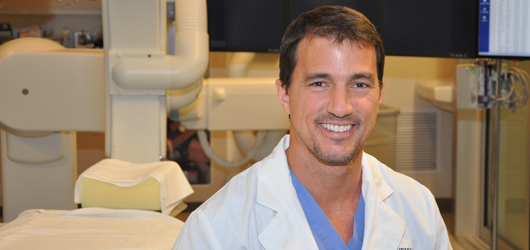
The history of medicine also includes the history of medical devices, a twisting path of ingenuity, unexpected failures, and back-to-the-drawing-board optimism and hope. Andrew Ringer, MD, a Mayfield Clinic neurosurgeon and endovascular specialist, recently reviewed the chapter of medical device history related to the treatment of brain aneurysms.Ever since 1937, when Dr. Walter Dandy became the first person to clip an aneurysm, physicians, designers, and manufacturers have worked to create devices that would render aneurysms harmless by shutting off their blood supply, Dr. Ringer told attendees at a lecture hosted by the Center for Clinical and Translational Science and Training (CCTST) on the University of Cincinnati Academic Health Center campus. Innovation has been driven by physicians who try to push the envelope and by industries that seek to differentiate their products in the marketplace, Dr. Ringer said.
In 1952, Frank H. Mayfield, MD, founder of the Mayfield Clinic and a pioneer in the treatment of brain aneurysms, created the Mayfield clip and clip applier with assistance from George Kees, a medical illustrator.
Today, Dr. Ringer and other endovascular specialists have several options at their disposal: an aneurysm clip (that evolved from Dr. Mayfield’s invention), which is attached during surgery to a narrow aneurysm neck; platinum coils, which are threaded up to the aneurysm through the body and inserted into the aneurysm; and a glue-like substance that can be released into the aneurysm, where it hardens.
Filling aneurysms with detachable coils, a procedure first used in 1992, translates into significant benefits. It enables a patient to avoid a craniotomy (an opening of the skull), and allows doctors to treat some previously unreachable aneurysms. But coiling also has had some notable drawbacks, Dr. Ringer said.
Coils that are inserted into wide-necked aneurysms sometimes migrate back into the artery. To counteract that problem, bio-designers came up with a solution: barricade the coils inside the aneurysm by placing a porous stent across the aneurysm’s wide neck.
“However, with a new development, we found new problems,” Dr. Ringer said. “We couldn’t always get the stents to go where we wanted.”
Coiling also posed another difficulty. Because coils filled only 25 percent of the space within the aneurysm, a percentage of coiled aneurysms would regain their blood supply and begin to grow again. “As a result, new coils were developed,” Dr. Ringer said. “We saw bioactive coils, which were wrapped with PGLA, a material designed to form scar tissue over the aneurysm neck, sealing it shut. We also saw expandable coils, which expanded like a sponge and filled up the nooks and crannies of the aneurysm.”
Both models made “a lot of sense,” Dr. Ringer said. Both worked well in animal models, and both came onto the market.
“But once doctors began using them, we saw drawbacks,” Dr. Ringer continued. “They would get stuck on the catheter during insertion, and we saw more blood clots and blockages of the flow of cerebrospinal fluid. Ultimately, none of these new coils performed better than the bare, old-fashioned platinum coils.”
Meanwhile, liquid embolics, such as Onyx®, have provided an important new alternative in the treatment of aneurysms with wide necks. “Our ability to utilize this treatment and prevent recurrence is better than with coiling,” Dr. Ringer said.
Today, flow-diversion devices are the newest aneurysm-fighting innovation. These devices resemble the flexible stents used to keep coils in place. But unlike previous lattice models that were highly porous, these new stents are dense and act more like pipes. Placed in the blood vessel next to the aneurysm, they form a barrier that diverts the blood flow away from the aneurysm.
Sanjay Shrivastava, PhD, Director of Technological Marketing for Covidien, said it is vital that physicians, bio-engineers and manufacturers continue to work together to produce innovative new medical devices. “Physician-industry partnerships are important,” he said. “We need clinicians to participate on industry advisory boards and to train other physicians.”
— Cindy Starr